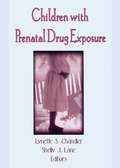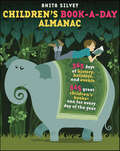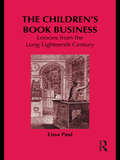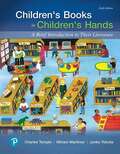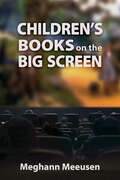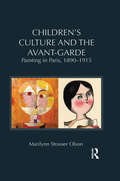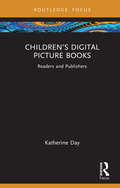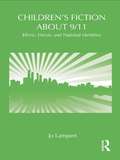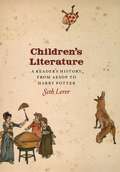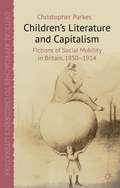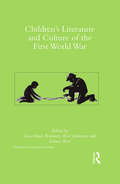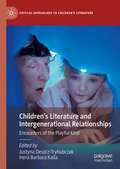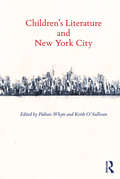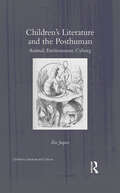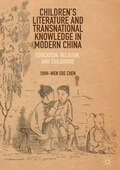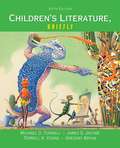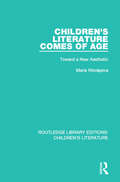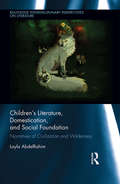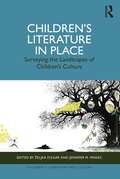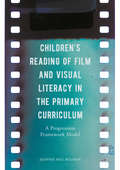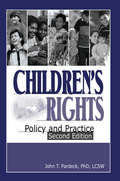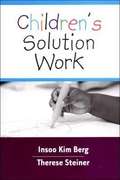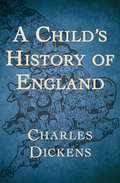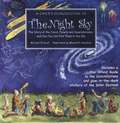- Table View
- List View
Children With Prenatal Drug Exposure
by Lynette S Chandler Shelly J LaneChildren With Prenatal Drug Exposure examines new medical approaches for predicting the developmental progress of children who have been exposed to drugs in utero. This book outlines effective methods for intervention and assessment and indicates future directions for investigation. It provides practical and up-to-date information on treatments and research development, while it encourages practitioners to come to their own conclusions through careful documentation and analysis of each case.Children With Prenatal Drug Exposure cuts across many disciplines to provide the reader with a vivid analysis of the complexities and challenges surrounding health care of children who have been prenatally exposed to drugs. This guidebook explores the controversies over treatment and therapy options and the ethics of care. It advocates positive outcome intervention methods that promote the health interests of both mother and unborn child whenever possible, with an emphasis on clinical efforts geared to change maternal behavior.Practical and comprehensive, Children With Prenatal Drug Exposure explores a full range of provoking topics, including: neurological effects and sensory motor delays caused by cocaine exposure foster care and its impact on motor development adolescent pregnancy and the complications of prenatal substance abuse ethical dilemmas multidimensional measurement systems and longitudinal researchThe book’s authors believe that in order to meet the needs of children who have been prenatally exposed to drugs, care providers must know the limitations associated with the process and methodology of assessment and learn to address the shortcomings of evaluation. With this in mind, this book aims to equip psychologists, physical and occupational therapists, researchers, and physicians with the “know-how” they require for optimizing their health care services and contributing valuable research that the field so urgently needs.
Children's Book-a-Day Almanac
by Anita SilveyPart fun- and information-filled almanac, part good book guide, the Children's Book-a-Day Almanac is a new way to discover a great children's book--every day of the year!This fresh, inventive reference book is a dynamic way to showcase the gems, both new and old, of children's literature. Each page features an event of the day, a children's book that relates to that event, and a list of other events that took place on that day. Always informative and often surprising, celebrate a year of literature for children with The Children's Book-a-Day Almanac.
The Children's Book Business: Lessons from the Long Eighteenth Century (Children's Literature and Culture)
by Lissa PaulIn The Children’s Book Business, Lissa Paul constructs a new kind of book biography. By focusing on Eliza Fenwick’s1805 product-placement novel, Visits to the Juvenile Library, in the context of Marjorie Moon’s 1990 bibliography, Benjamin Tabart’s Juvenile Library, Paul explains how twenty-first century cultural sensibilities are informed by late eighteenth-century attitudes towards children, reading, knowledge, and publishing. The thinking, knowing children of the Enlightenment, she argues, are models for present day technologically-connected, socially-conscious children; the increasingly obsolete images of Romantic innocent and ignorant children are bracketed between the two periods. By drawing on recent scholarship in several fields including book history, cultural studies, and educational theory, The Children’s Book Business provides a detailed historical picture of the landscape of some of the trade practices of early publishers, and explains how they developed in concert with the progressive pedagogies of several female authors, including Eliza Fenwick, Mary Wollstonecraft, Anna Barbauld, Maria Edgeworth, and Ann and Jane Taylor. Paul’s revisionist reading of the history of children’s literature will be of interest to scholars working in eighteenth-century studies, book history, childhood studies, cultural studies, educational history, and children’s literature.
Children's Books in Children's Hands: A Brief Introduction to Their Literature
by Charles Temple Miriam Martinez Junko YokotaChildren’s Books in Children’s Hands: A Brief Introduction to Their Literature familiarizes current and future teachers with the best and most recent books for children. The renowned author team presents richly illustrated, practical ideas for sharing literature with children as a source of enjoyment and inspiration that will last them all their lives. This authoritative, captivating, and popular guide establishes a roadmap for understanding the world of children’s literature, including its writers, illustrators, editors, and critics, while also providing a strong emphasis on books from many cultural groups. <p><P>The 6th Edition now includes full color illustrations and art, newer title annotations, new teaching ideas, coverage of shifting changes in genres, and thorough coverage of multicultural and international books.
Children's Books on the Big Screen (Children's Literature Association Series)
by Meghann MeeusenIn Children’s Books on the Big Screen, Meghann Meeusen goes beyond the traditional adaptation approach of comparing and contrasting the similarities of film and book versions of a text. By tracing a pattern across films for young viewers, Meeusen proposes that a consistent trend can be found in movies adapted from children’s and young adult books: that representations of binaries such as male/female, self/other, and adult/child become more strongly contrasted and more diametrically opposed in the film versions. The book describes this as binary polarization, suggesting that starker opposition between concepts leads to shifts in the messages that texts send, particularly when it comes to representations of gender, race, and childhood. After introducing why critics need a new way of thinking about children’s adapted texts, Children’s Books on the Big Screen uses middle-grade fantasy adaptations to explore the reason for binary polarization and looks at the results of polarized binaries in adolescent films and movies adapted from picture books. Meeusen also digs into instances when multiple films are adapted from a single source such as The Wonderful Wizard of Oz and ends with pragmatic classroom application, suggesting teachers might utilize this theory to help students think critically about movies created by the Walt Disney corporation. Drawing from numerous popular contemporary examples, Children’s Books on the Big Screen posits a theory that can begin to explain what happens—and what is at stake—when children’s and young adult books are made into movies.
Children's Culture and the Avant-Garde: Painting in Paris, 1890-1915 (Children's Literature and Culture #86)
by Marilynn Strasser OlsonThis volume explores the mutual influences between children’s literature and the avant-garde. Olson places particular focus on fin-de-siècle Paris, where the Avant-garde was not unified in thought and there was room for modernism to overlap with children’s literature and culture in the Golden Age. The ideas explored by artists such as Florence Upton, Henri Rousseau, Sir William Nicholson, Paula Modersohn-Becker, and Marc Chagall had been disseminated widely in cultural productions for children; their work, in turn, influenced children’s culture. These artists turned to children’s culture as a "new way of seeing," allied to a contemporary interest in international artistic styles. Children’s culture also has strong ties to decadence and to the grotesque, the latter of which became a distinctively Modernist vision. This book visits the qualities of the era that were defined as uniquely childlike, the relation of childhood to high and low art, and the relation of children’s literature to fin-de-siècle artistic trends. Topics of interest include the use of non-European figures (the Golliwogg), approaches to religion and pedagogy, to oppression and motherhood, to Nature in a post-Darwinian world, and to vision in art and life. Olson’s unique focus covers new ground by concentrating not simply on children's literature, but on how childhood experiences and culture figure in art.
Children’s Digital Picture Books: Readers and Publishers
by Katherine DayDuring the COVID-19 pandemic lockdowns, children’s media use increased (Mesce et al. 2021) while a decrease in print-book reading was observed (Nolan et al. 2022). An increase in tablet use suggests that when children were reading, it was mostly online in the form of ePub3 pdf files for illustrated works and prescribed school texts, while smartphone use was linked to apps and games. (Susilowati et al. 2021) For many years now, children’s publishers have experimented with digital picture-book formats but have regarded the genre as not suitable for digitisation.This book documents the findings of a one-year research project engaging the children’s publishing sector for feedback on reading trends and digital publishing in picture-book genres. The research assesses the plight of picture books in the current climate and considers how picture-book publishers cater to diverse readerships and new reading platforms post Covid-19 lockdowns and into the digital age.Written by an academic and editor with over 15 years industry experience, this book offers a nuanced response to children’s picture book publishing and reception for librarians, teachers, publishers and international scholars in the fields of publishing studies, library studies, early childhood studies, early education and childhood psychology.
Children's Fantasy Literature
by Michael Levy Farah Mendlesohn Levy MichaelFantasy has been an important and much-loved part of children's literature for hundreds of years, yet relatively little has been written about it. Children's Fantasy Literature traces the development of the tradition of the children's fantastic - fictions specifically written for children and fictions appropriated by them - from the sixteenth to the twenty-first century, examining the work of Lewis Carroll, L. Frank Baum, C. S. Lewis, Roald Dahl, J. K. Rowling and others from across the English-speaking world. The volume considers changing views on both the nature of the child and on the appropriateness of fantasy for the child reader, the role of children's fantasy literature in helping to develop the imagination, and its complex interactions with issues of class, politics and gender. The text analyses hundreds of works of fiction, placing each in its appropriate context within the tradition of fantasy literature.
Children's Fiction about 9/11: Ethnic, National and Heroic Identities (Children's Literature and Culture)
by Jo LampertIn this pioneering and timely book, Lampert examines the ways in which cultural identities are constructed within young adult and children’s literature about the attacks of September 11, 2001. Looking at examples including picture books, young adult novels, and a selection of DC Comics, Lampert finds the co-mingling of xenophobia and tolerance, the binaried competition between good and evil and global harmony and national insularity, and the glorification of both the commonplace hero and the super-human. Specifically, Lampert identifies three significant identity categories encoded in 9/11 books for children--ethnic identities, national identities, and heroic identities--arguing that their formation is contingent upon post-9/11 politics. These shifting identities offer implicit and explicit accounts of what constitute good citizenship, loyalty to nation and community, and desirable attributes in a Western post-9/11 context. Lampert makes an original contribution to the field of children’s literature by providing a focused and sustained analysis of how texts for children about 9/11 contribute to formations of identity in these complex times of cultural unease and global unrest.
Children's Literature: A Reader's History, from Aesop to Harry Potter
by Seth LererEver since children have learned to read, there has been children's literature. It is inseparable from the history of childhood. The tales they hear and read molds children. They will one day share these with their own children.
Children's Literature and Capitalism
by Christopher ParkesAfter the first phase of industrialization in Britain, the child emerged as both a victim of and a threat to capitalism. This book explores the changing relationship between the child and capitalist society in the works of some of the most important writers of children's and young-adult texts in the Victorian and Edwardian periods.
Children's Literature and Culture of the First World War (Children's Literature and Culture)
by Emma Short Lissa Paul Rosemary R. JohnstonBecause all wars in the twenty-first century are potentially global wars, the centenary of the first global war is the occasion for reflection. This volume offers an unprecedented account of the lives, stories, letters, games, schools, institutions (such as the Boy Scouts and YMCA), and toys of children in Europe, North America, and the Global South during the First World War and surrounding years. By engaging with developments in Children’s Literature, War Studies, and Education, and mining newly available archival resources (including letters written by children), the contributors to this volume demonstrate how perceptions of childhood changed in the period. Children who had been constructed as Romantic innocents playing safely in secure gardens were transformed into socially responsible children actively committing themselves to the war effort. In order to foreground cross-cultural connections across what had been perceived as ‘enemy’ lines, perspectives on German, American, British, Australian, and Canadian children’s literature and culture are situated so that they work in conversation with each other. The multidisciplinary, multinational range of contributors to this volume make it distinctive and a particularly valuable contribution to emerging studies on the impact of war on the lives of children.
Children’s Literature and Intergenerational Relationships: Encounters of the Playful Kind (Critical Approaches to Children's Literature)
by Justyna Deszcz-Tryhubczak Irena Barbara KallaChildren’s Literature and Intergenerational Relationships: Encounters of the Playful Kind explores ways in which children’s literature becomes the object and catalyst of play that brings younger and older generations closer to one another. Providing examples from diverse cultural and historical contexts, this collection argues that children’s texts promote intergenerational play through the use of literary devices and graphic formats and that they may prompt joint play practices in the real world. The book offers a distinctive contribution to children’s literature scholarship by shifting critical attention away from the difference and conflict between children and adults to the exploration of inter-age interdependencies as equally crucial aspects of human life, presenting a new perspective for all who research and work with children’s culture in times of global aging.
Children's Literature and New York City (Children's Literature and Culture)
by Pádraic Whyte Keith O’SullivanThis collection explores the significance of New York City in children’s literature, stressing literary, political, and societal influences on writing for young people from the twentieth century to the present day. Contextualized in light of contemporary critical and cultural theory, the chapters examine the varying ways in which children’s literature has engaged with New York City as a city space, both in terms of (urban) realism and as an ‘idea’, such as the fantasy of the city as a place of opportunity, or other associations. The collection visits not only dominant themes, motifs, and tropes, but also the different narrative methods employed to tell readers about the history, function, physical structure, and conceptualization of New York City, acknowledging the shared or symbiotic relationship between literature and the city: just as literature can give imaginative ‘reality’ to the city, the city has the potential to shape the literary text. This book critically engages with most of the major forms and genres for children/young adults that dialogue with New York City, and considers such authors as Margaret Wise Brown, Felice Holman, E. L. Konigsburg, Maurice Sendak, J. D. Salinger, John Donovan, Shaun Tan, Elizabeth Enright, and Patti Smith.
Children's Literature and the Posthuman: Animal, Environment, Cyborg (Children's Literature and Culture)
by Zoe JaquesAn investigation of identity formation in children's literature, this book brings together children’s literature and recent critical concerns with posthuman identity to argue that children’s fiction offers sophisticated interventions into debates about what it means to be human, and in particular about humanity’s relationship to animals and the natural world. In complicating questions of human identity, ecology, gender, and technology, Jaques engages with a multifaceted posthumanism to understand how philosophy can emerge from children's fantasy, disclosing how such fantasy can build upon earlier traditions to represent complex issues of humanness to younger audiences. Interrogating the place of the human through the non-human (whether animal or mechanical) leads this book to have interpretations that radically depart from the critical tradition, which, in its concerns with the socialization and representation of the child, has ignored larger epistemologies of humanness. The book considers canonical texts of children's literature alongside recent bestsellers and films, locating texts such as Gulliver’s Travels (1726), Pinocchio (1883) and the Alice books (1865, 1871) as important works in the evolution of posthuman ideas. This study provides radical new readings of children’s literature and demonstrates that the genre offers sophisticated interventions into the nature, boundaries and dominion of humanity.
Children’s Literature and Transnational Knowledge in Modern China: Education, Religion, and Childhood
by Shih-Wen Sue ChenThis book examines the development of Chinese children’s literature from the late Qing to early Republican era. It highlights the transnational flows of knowledge, texts, and cultures during a time when children’s literature in China and the West was developing rapidly. Drawing from a rich archive of periodicals, novels, tracts, primers, and textbooks, the author analyzes how Chinese children’s literature published by Protestant missionaries and Chinese educators in the late nineteenth and early twentieth centuries presented varying notions of childhood. In this period of dramatic transition from the dynastic Qing empire to the new Republican China, young readers were offered different models of childhood, some of which challenged dominant Confucian ideas of what it meant to be a child. This volume sheds new light on a little-explored aspect of Chinese literary history. Through its contributions to the fields of children’s literature, book history, missionary history, and translation studies, it enhances our understanding of the negotiations between Chinese and Western cultures that shaped the publication and reception of Chinese texts for children.
Children's Literature, Briefly
by Michael Tunnell James Jacobs Terrell Young Gregory BryanA concise, engaging, practical overview of children’s books that keeps the focus on the books themselves, this brief introduction to children’s literature genres leaves time to actually read children’s books. Written on the assumption that the focus of a children’s literature course should be on the actual books that children read, the authors first wrote this book in 1996 as a “textbook for people who don’t like children’s literature textbooks.” Today it serves as an overview to shed light on the essentials of children’s literature and how to use it effectively with young readers, from PreK to 8th grade.
Children's Literature Comes of Age: Toward a New Aesthetic (Routledge Library Editions: Children's Literature)
by Maria NikolajevaOriginally published in 1996. A detailed analysis of the art of children's literature covering world literature for children, children's literature as a canonical art form, the history of children's literature from a semiotic perspective, and epic, polyphony, chronotope, intertextuality, and metafiction in children's literature.
Children's Literature, Domestication, and Social Foundation: Narratives of Civilization and Wilderness (Routledge Interdisciplinary Perspectives on Literature)
by Layla AbdelRahimThis study of children's literature as knowledge, culture, and social foundation bridges the gap between science and literature and examines the interconnectedness of fiction and reality as a two-way road. The book investigates how the civilized narrative orders experience by means of segregation, domestication, breeding, and extermination, arguing instead that the stories and narratives of wilderness project chaos and infinite possibilities for experiencing the world through a diverse community of life. AbdelRahim engages these narratives in a dialogue with each other and traces their expression in the various disciplines and books written for both children and adults, analyzing the manifestation of fictional narratives in real life. This is both an inter- and multi-disciplinary endeavor that is reflected in the combination of research methods drawn from anthropology and literary studies as well as in the tracing of the narratives of order and chaos, or civilization and wilderness, in children's literature and our world. Chapters compare and contrast fictional children's books that offer different real-world socio-economic paradigms, such as A.A. Milne's Winnie-the-Pooh projecting a civilized monarcho-capitalist world, Nikolai Nosov's trilogy on The Adventures of Dunno and Friends presenting the challenges and feats of an anarcho-socialist society in evolution from primitivism towards technology, and Tove Jansson's Moominbooks depicting the harmony of anarchy, chaos, and wildness. AbdelRahim examines the construction, transmission, and acquisition of knowledge in children’s literature by visiting the very nature of literature, culture, and language and the civilized structures that domesticate the world. She brings radically new perspectives to the knowledge, culture, and construction of human beings, making an invaluable contribution to a wide range of disciplines and for those engaged in revolutionizing contemporary debates on the nature of knowledge, human identity, and the world.
Children’s Literature in Place: Surveying the Landscapes of Children’s Culture (Children's Literature and Culture)
by Željka Flegar Jennifer M. MiskecChildren’s Literature in Place: Surveying the Landscapes of Children’s Culture is an edited collection dedicated to individual, international, and interdisciplinary considerations of the places and spaces of children’s literature, media, and culture, from content to methodology, in fictional, virtual, and material settings. This volume proposes a survey of the changing landscapes of children’s culture, the expected and unexpected spaces and places that emerge as and because of children’s culture. The places and spaces of children’s literature are varied and diverse. By making place studies a guiding principle, this book builds on the impressive body of international research on place in children’s literature, media, and culture to bring together and provide a comprehensive overview of how to study place in children’s and young adult literature. This volume provides a wide range of approaches and international perspectives of place in children’s literature, media, and culture and contributes to this growing and relevant field by showcasing various scholarly aspects and approaches to children’s literature, and the place of children’s literature in the context of international scholarship.
Children's Reading of Film and Visual Literacy in the Primary Curriculum: A Progression Framework Model
by Jeannie Hill BulmanThis book draws on a longitudinal study which highlights the beneficial impact of film in the primary curriculum. It provides detailed accounts of both the reading process as understood within the field of literacy education, and of film theory as it relates to issues such as narration, genre and audience. The book focuses on a small cohort of children to explore how progression in reading film develops throughout a child's time in Key Stage 2; it also examines how the skills and understanding required to read film can support the reading of print, and vice versa, in an 'asset model' approach. Since children's progression in reading film is found to be not necessarily age-related, but rather built on a period of experience and opportunity to read and/or create moving image media, Bulman clearly illustrates the importance of the inclusion of film in the primary curriculum. The book provides an accessible study to a large audience of primary teachers and practitioners, and will be a valuable resource for students and researchers in the fields of education, English and media studies.
Children's Rights: Policy and Practice, Second Edition
by Jean A. PardeckGet up-to-date information on children&’s and parent&’s rightsChildren have a basic human right to be free of abuse and maltreatment. The late Dr. John Pardeck&’s Children&’s Rights: Policy and Practice, Second Edition comprehensively explores the latest legal, psychological, sociological, policy, and child advocacy issues dealing with children&’s rights. Essential issues are clearly discussed involving children at home, in school, in foster care, and in residential facilities. This new edition of The Haworth Social Work Practice Press classic examines the practical and ethical issues inherent in balancing a child&’s right to self-determination against the same child&’s need to be protected.Children&’s Rights: Policy and Practice, Second Edition delves deep into the causes of abuse and neglect and offers help for families at risk. Techniques are presented for case and cause advocacy, as well as venues for family and individual therapy. Other discussions address the role and function of child protective services and the juvenile justice system, a review of effective social policy to protect and care for children, family health and children&’s rights issues, and children&’s rights in schools and day care facilities. This essential exploration includes extensive references and notes, a list of Web sites, and a comprehensive glossary of influential legal rulings focusing on children&’s rights.Children&’s Rights: Policy and Practice, Second Edition includes over 100 pages of new and updated material on: new rulings of the Americans with Disabilities Act (ADA) that have implications for children&’s rights legal case studies an overview and analysis of the Leave No Child Behind Act children&’s rights and school violence an expanded discussion on practice interventions focusing on various approaches for helping children adjust to substitute care an expanded examination on advocacy and children&’s rights, with emphasis on legal case studies as a tool for enhancing the rights of childrenBalancing theoretical considerations, solid information, and practical advice, Children&’s Rights: Policy and Practice, Second Edition is an essential resource for child welfare workers, attorneys, educators, students, parents, and social workers.
Children's Solution Work
by Insoo Kim BergFocusing on solutions and not problems, thinking about the future and not the past, and understanding the effects of miracles―children do these things naturally. Here, leaders in the solution-focused approach to therapy provide clinicians with a guide to a kind of therapy that fits with children's natural way of being.
A Child's History of England
by Charles DickensCharles Dickens’s charming history of his homeland, spanning from antiquity through the 17th century In this accessible history volume, Charles Dickens turns his talents to the saga of the United Kingdom. With characteristic wit and perspicacity, he brings the kings, soldiers, and civilians who shaped England, Scotland, and Ireland to vivid life. Beginning in 50 B.C.E. and extending through the reign of James II in 1688, this immensely readable book offers readers a complete and engaging look at England’s past. Originally appearing in serial form, A Child’s History of England provides rare snapshots of Britain throughout the ages as rendered by an unparalleled master. This ebook has been professionally proofread to ensure accuracy and readability on all devices.
A Child's Introduction To The Night Sky: The Story Of The Stars, Planets And Constellations - And How You Can Find Them In The Sky (Child's Introduction Series)
by Michael Driscoll Meredith Hamilton<P>Children eight and up will enjoy this conversational but information-packed introduction to astronomy and stargazing, which includes the achievements of the great scientists, the history of space exploration, the story of our solar system, the myths behind the constellations, and how to navigate the night sky. <P>Whimsical color illustrations on every page and handy definitions and sidebars help engage younger readers and develop their interest. <P>The special star wheel helps locate stars and planets from any location at any time of year.<P> This is the third in Black Dog & Leventhal's successful series including The Story of the Orchestra and A Child's Introduction to Poetry.
